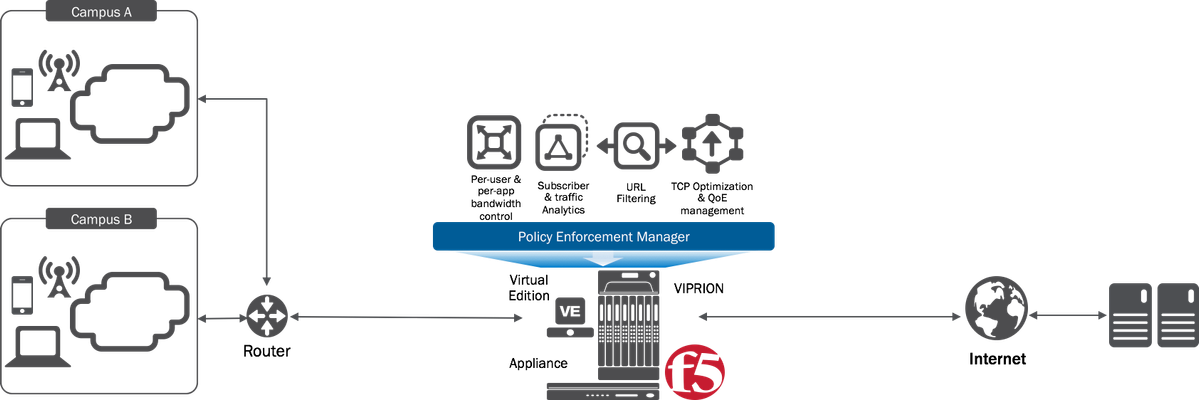big-ip pem
4 TopicsPEM: Key Component of the Next Generation University Network
In recent years, higher education institutions have become significant providers of digital services and content, ranging from mesh WiFi access to virtual-classroom services featuring high-bandwidth real-time collaboration experiences for on-campus and remote students alike. In fact, many Universities’ IT networks have become so large, they now compete with some regional Service Providers based on the amount of data they process and route within their IT infrastructure. Students, classrooms, staff, and guests all need to have reliable access to Campus LAN and Internet services simultaneously. However, with growing number of consumers, internal and outbound routes can become quickly saturated and oversubscribed, resulting in slow response times and degraded performance of the entire university network. To prevent chaos and limit data-hungry devices from clogging up data links, Universities have begun to employ certain services usually found in Service Provider (SP) networks. In particular, Policy and Charging Control (PCC) elements that: Are subscriber - aware Assign QoS to applications and services Perform application layer data inspection Enforce subscriber and application policies Ensure compliance with State and Federal laws Prevent access to inappropriate content Provide visibility and reporting So, how does the modern University achieve this without having to build a full-blown Evolved Packet Core inside their IT Network? Some have implemented the list in parts using different network elements, but this approach offers limited centralized visibility and/or traffic control, while others use the aging Cisco SCE, which will be End-of-Life on September 30th of 2018. The most progressive University IT teams quickly realized the benefits of having a subscriber-aware policy enforcement device, and turned to F5 Policy Enforcement Manager (PEM) as a full and integral solution that optimizes network resources and allows for optimal channel utilization, ultimately leading to improved user experience and substantial financial savings for Universities due to much more efficient use of available bandwidth. Pic 1. F5 Policy Enforcement Manager Any school or other organization which implemented PEM in their network can achieve a “subscriber” (in SP terms) or end-user (in enterprise terms) granularity. That means every user connecting to the School or University network can be assigned a Policy with certain rules which dictate how this user will be treated by the network. For example, some students may be given a preferential access to certain network resources and applications while faculty members may have an unrestricted Internet access with higher priority during classes and post-class activities. By categorizing users and applications network can achieve better utilization, ensure fair resource consumption and provide the best experience for all users Pic 2. Per-Subscriber Policy In addition to subscribers, PEM also implements a “per-application” concept. It provides the most comprehensive and agile configuration of policies when combined with subscriber and global policy scopes. This capability enables the University to limit or block certain application types - i.e. P2P Torrent traffic, various messengers, or social networks. Pic 3. Per-Application Policy SSL Visibility is a crucial part of Network monitoring and content filtering in Public Networks. By terminating the SSL (or TLS) connection from users and establishing new SSL connection to application servers, PEM makes it possible to perform: SNI analysis and classification Traffic content inspection and manipulation Detailed reporting and data visualization Pic 4. SSL Forward Proxy URL Classification and Filtering is another important aspect of managing IT network in Schools or Universities. Age-appropriate content must be enforced for students and other users, while maintaining the up-to-date list of blacklisted and malicious websites. PEM utilizes a Webroot-provided DB for precise URL categorization. With more than 80 URL categories available including live updates and custom categories, URL classification and enforcement becomes an effortless and efficient automatic routine. PEM also enables custom HTML content insertion into HTTP traffic, which can be used to warn users about a potentially harmful website or blocked internet resource by URL Filtering engine. Pic 5. URL Classification and Enforcement Schools can also realize significant savings on bandwidth by using Policy Enforcement Manager’s Video Pacing feature. PEM ensures that video content is pre-loaded at the same or similar pace as consumed by the user. By doing so it eliminates wasted bandwidth and traffic spikes that are produced by multiple users accessing video resources at the same time. Without video pacing, video pre-loading is triggered when a user starts watching content, making entire length of content available for viewing. Sometimes users stop watching the content before the end of video file, effectively throwing out unconsumed portion of pre-loaded video. PEM ensures that no unnecessary content is pre-loaded, so that no bandwidth is wasted. Pic 6. Video Pre-loaded, no pacing used Pic 7. PEM uses video pacing Network Visibility and Reporting plays a significant role in the Network Management domain. By knowing exactly what is happening in near real-time, Network Administrators are empowered to identify violations and fix issues before they impact other users in school network. PEM provides both on-the-box analytics and exported data to be used for reporting and visualization using third party tools. Pic 8. Data export options Policy Enforcement Manager enables Schools or Universities to implement alternative, Service Provider-oriented network architectures delivering: More granular control and visibility Optimized user experience Savings on Internet Services. Next in this series, we will be diving into deeper detail on how Universities can best leverage the various features of PEM covered here. Stay tuned!448Views2likes0Comments
